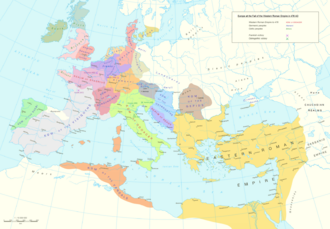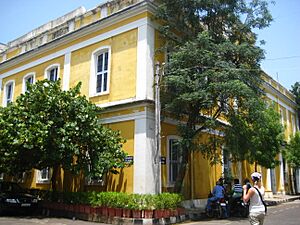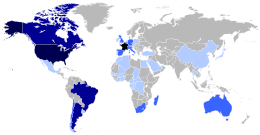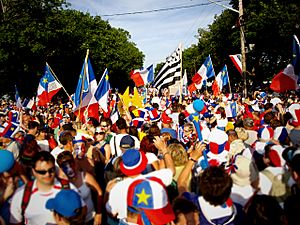French people facts for kids
| Total population | ||||||||||||||||||||||||||||||||||||||||||||||||||||||||||||||||||||||||||||||||
|---|---|---|---|---|---|---|---|---|---|---|---|---|---|---|---|---|---|---|---|---|---|---|---|---|---|---|---|---|---|---|---|---|---|---|---|---|---|---|---|---|---|---|---|---|---|---|---|---|---|---|---|---|---|---|---|---|---|---|---|---|---|---|---|---|---|---|---|---|---|---|---|---|---|---|---|---|---|---|---|---|
| c. 100 million France: 67,413,000 |
||||||||||||||||||||||||||||||||||||||||||||||||||||||||||||||||||||||||||||||||
| Regions with significant populations | ||||||||||||||||||||||||||||||||||||||||||||||||||||||||||||||||||||||||||||||||
| France | 67,413,000 (including overseas departments) |
|||||||||||||||||||||||||||||||||||||||||||||||||||||||||||||||||||||||||||||||
| United States (2020) | 9,373,000 (includes ancestry) | |||||||||||||||||||||||||||||||||||||||||||||||||||||||||||||||||||||||||||||||
| Argentina | 6,000,000 (includes ancestry) | |||||||||||||||||||||||||||||||||||||||||||||||||||||||||||||||||||||||||||||||
| Canada (2016) | 4,995,000 (includes ancestry) | |||||||||||||||||||||||||||||||||||||||||||||||||||||||||||||||||||||||||||||||
| United Kingdom | 3,000,000 (ancestry) 300,000 |
|||||||||||||||||||||||||||||||||||||||||||||||||||||||||||||||||||||||||||||||
| Brazil | 1,000,000 (includes ancestry) | |||||||||||||||||||||||||||||||||||||||||||||||||||||||||||||||||||||||||||||||
| Chile | 800,000 (includes ancestry) | |||||||||||||||||||||||||||||||||||||||||||||||||||||||||||||||||||||||||||||||
| Switzerland | 159,000 | |||||||||||||||||||||||||||||||||||||||||||||||||||||||||||||||||||||||||||||||
| Madagascar | 124,000 | |||||||||||||||||||||||||||||||||||||||||||||||||||||||||||||||||||||||||||||||
| Belgium | 123,000 | |||||||||||||||||||||||||||||||||||||||||||||||||||||||||||||||||||||||||||||||
| Spain | 122,000 | |||||||||||||||||||||||||||||||||||||||||||||||||||||||||||||||||||||||||||||||
| Australia | 118,000 | |||||||||||||||||||||||||||||||||||||||||||||||||||||||||||||||||||||||||||||||
| Portugal | 104,000 | |||||||||||||||||||||||||||||||||||||||||||||||||||||||||||||||||||||||||||||||
Historically, the French people come from many different groups. These include the Romans (also called Gallo-Romans), Gauls (ancient Celtic people), and Germanic peoples like the Franks. Over time, people from other parts of Europe and the world have also moved to France. This has made French society a mix of many cultures. ContentsWho are the French People?To be French means to be a citizen of France. The French Constitution says that everyone who is a citizen is French, no matter their background, race, or religion. France sees itself as an open country with values that apply to everyone. France has always welcomed people from other countries. However, it also expects newcomers to adopt French values and culture. This idea is called assimilation. Today, the government allows new arrivals to keep their own cultures. But French citizens still connect their nationality with being a citizen of France. A Look at French HistoryThe history of the French people is a mix of many groups. These include the Celts (or Gauls), Romans, and various Germanic peoples. The name "France" comes from the Franks, a Germanic tribe that settled in Gaul after the Roman Empire fell. Ancient Gaul and Roman Times
Map of Gaul before complete Roman conquest (c. 58 BCE).
Long ago, the area now known as France was called Gaul. It was home to many different tribes, mostly Celts. The Roman legions led by Julius Caesar conquered Gaul between 58 and 51 BCE. For the next 600 years, Roman and Gaulish cultures mixed, creating a unique Gallo-Roman culture. Even though Latin became common, the Gaulish language influenced the Vulgar Latin that later became French. Today, the Breton language is still spoken in Brittany. This is because Brythonic-speaking Celts from Britain moved there in the 5th century. The Frankish Kingdom
Barbarian kingdoms and peoples after the end of the Western Roman Empire in 476 AD.
After the Roman Empire declined, the Franks, a Germanic group, became powerful in Gaul. By the 6th century, their king, Clovis I, controlled much of modern France. Other Germanic groups like the Burgundians and Visigoths also settled there. Later, in the 9th and 10th centuries, Norsemen (Vikings) from Denmark and Norway settled in a region called Normandy. They mixed with the local people and became known as the Normans. These Normans later conquered England and parts of Southern Italy. The Kingdom of France
Louis XIV of France "The Sun-King".
Unlike some other European countries, France did not have many people leave for the Americas. However, some French people, especially Roman Catholics, did settle in places like Acadia, Canada (New France), and Louisiana. They also went to colonies in the West Indies and Africa. In 1608, Samuel de Champlain founded Quebec City, which became the capital of New France. By 1763, New France had about 65,000 people. French Huguenots also settled in South Africa in 1687, but they soon blended into the local population. The French Republic and Modern TimesThe French First Republic began after the French Revolution in 1789. This marked the end of the old kingdom ruled by kings. The Franco-Prussian War in 1870 helped strengthen feelings of national pride. In the 19th and 20th centuries, many immigrants came to France. They came from countries like Poland, Belgium, Portugal, Italy, and Spain. These newcomers quickly became part of French culture. After World War II, more immigrants arrived, especially from Maghreb countries (North Africa), to help rebuild France. Today, France is a diverse country with people from many backgrounds. The government aims for everyone to feel like part of the French nation. Languages Spoken in FranceMost French people speak the French language as their first language. However, some regions still speak their own traditional languages. These include Norman, Occitan languages, Corsican, Basque, French Flemish, and Breton. In the past, many French people spoke local languages more than French. Today, Arabic is also widely spoken, making it a major minority language in France. French Identity and CitizenshipFrance has always valued the idea of a single, shared national culture. The French government does not collect information about people's ethnic backgrounds or religions. This is because the French Republic believes in being secular and unified. The idea of being French is about being a citizen, not about belonging to a specific ethnic group. This is different from some other countries that define their nation by a common ethnic background. What is a Nation?A famous French thinker named Ernest Renan explained this idea in 1882. He said that belonging to a nation is a choice that people make every day. A nation is not just one ethnic group. It is a group of different people who want to live together. This idea means that the French nation includes everyone who lives in France and wants to be part of it. It is not based on things like race or a common language. This is why the French Constitution says that "French" is a nationality, not an ethnicity. How People Become FrenchIn the past, being born in France usually made you French (called jus soli, or "right of territory"). Later, the Napoleonic Code also emphasized being born to a French parent (called jus sanguinis, or "right of blood"). Today, French nationality law combines these ideas. It considers where you are born, your parents' nationality, and if you want to become French. For example, children born in France to foreign parents can become French citizens when they are older if they choose to. French People Around the WorldMany people with French roots live outside of France. Between 1848 and 1939, about 1 million people with French passports moved to other countries. French in CanadaNearly 7 million people in Canada speak French. The province of Quebec is the main center of French life in North America. Over 95% of people in Quebec speak French. There are also large French-Canadian communities in other provinces like Ontario and New Brunswick. French in the United StatesThe United States has about 13 to 16 million people of French descent. Many live in Louisiana, where they are known as Creoles (descendants of French settlers) and Cajuns (descendants of Acadian refugees). In New England, many French Americans came from Quebec to work in factories. Today, nearly 25% of the population of New Hampshire has French ancestry. French in ArgentinaFrench Argentines are the third largest ancestry group in Argentina. Many French immigrants came to Argentina between 1871 and 1890. Today, about 6.8 million Argentines have some French ancestry. They have influenced Argentina's architecture, literature, and science. French in UruguayFrench Uruguayans are the third largest ancestry group in Uruguay. In the early 19th century, Uruguay received many French immigrants, especially from the Basque Country. Today, about 300,000 people in Uruguay have French roots. French in the United KingdomMany British people have French ancestry. This is partly due to the Norman Conquest of England and later migrations. A study found that 3 million British people have French descent. Today, about 400,000 French people live in the United Kingdom, mostly in London. French in MexicoMexico has a large population with French ancestry, making France the second largest European group after Spain. Most French immigrants arrived in the 19th and early 20th centuries. Today, over 3 million Mexicans have full or partial French descent. French in ChileThe French arrived in Chile in the 18th century as merchants and later in the 19th century to grow grapes for wine. Many settled in the Araucanía Region. Today, it is estimated that 500,000 Chileans have French descent. Famous Chileans like former president Michelle Bachelet have French origins. French in Brazil
Brazil has one of the largest French communities in South America, with an estimated 1 to 2 million people of French descent. Many French people immigrated to Brazil between 1819 and 1940. The Brazilian Imperial Family also has French roots. French in Asia
Building of the École française d'Extrême-Orient in Pondicherry.
In Vietnam, some people have mixed French and Vietnamese heritage. A small number of people with French and Khmer (Cambodian) descent live in Cambodia. There are also a few thousand French citizens living in former French areas of India, like Pondicherry. French Huguenots ElsewhereMany Huguenots (French Protestants who fled religious persecution) settled in other countries. Large groups went to the United Kingdom, Ireland, Germany, the Netherlands, South Africa, and North America. Many people in these countries still have French names today. Images for kidsSee also
|
||||||||||||||||||||||||||||||||||||||||||||||||||||||||||||||||||||||||||||||||





 In Spanish:
In Spanish: